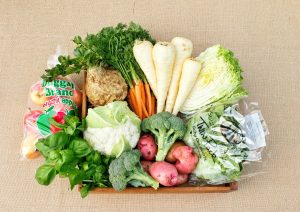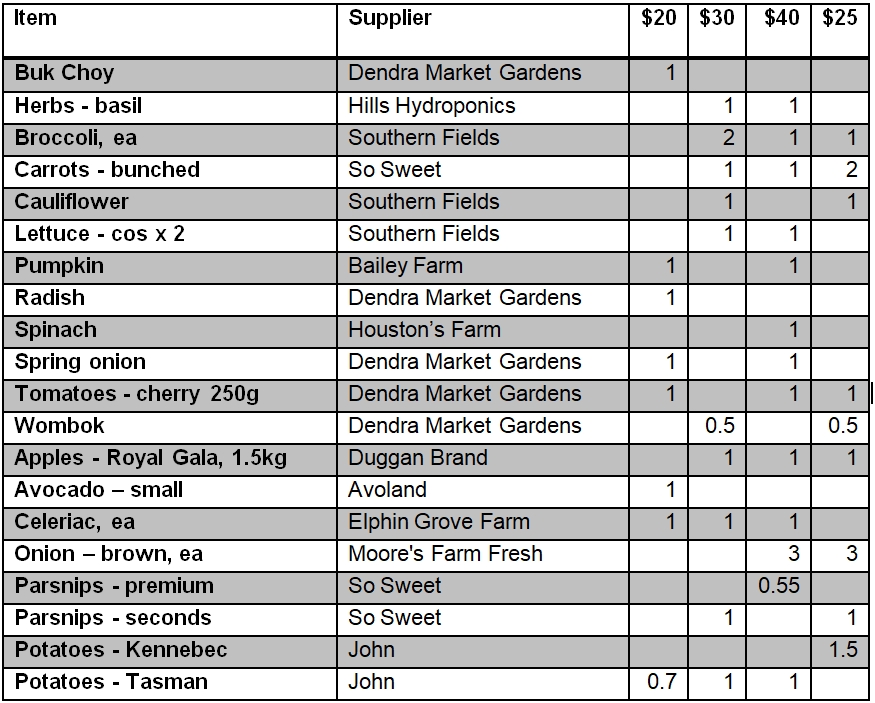 Making the most of your weekly box in winter, when there’s a narrower range of the Tasmanian only produce that we pack for you, means being creative with what’s available. Each week I unpack our box and work out a meal plan – my most common and quickest method is to arrange the contents of the box into groupings with compatible flavours and go from there, but this can also mean that I fall into habits, making the same types of dishes with the same sorts of vegetables. To bust out of this rut, another technique I use is drilling down on a particular vegetable and thinking about all the different ways it could be eaten – raw, boiled, roasted, grilled, cold, hot etc. If I’ve cooked it a particular way last week and I have it again this week, I’ll usually try to cook it a different way, or at the very least in a different combination.
Making the most of your weekly box in winter, when there’s a narrower range of the Tasmanian only produce that we pack for you, means being creative with what’s available. Each week I unpack our box and work out a meal plan – my most common and quickest method is to arrange the contents of the box into groupings with compatible flavours and go from there, but this can also mean that I fall into habits, making the same types of dishes with the same sorts of vegetables. To bust out of this rut, another technique I use is drilling down on a particular vegetable and thinking about all the different ways it could be eaten – raw, boiled, roasted, grilled, cold, hot etc. If I’ve cooked it a particular way last week and I have it again this week, I’ll usually try to cook it a different way, or at the very least in a different combination.
Wombok, for instance, can be happily used raw, boiled, fried or grilled, although one of its limitations is that it’s quite high in water. This could be considered a disadvantage (for instance if you were planning to make it into coleslaw), but it’s also a great advantage for fermenting! The general principles of fermentation are to mix whatever you’re fermenting with about 2% per weight of salt; this draws out the moisture, which allows the ferment to stay submerged, generating the lactic acid that is required for this process. The process for a basic cabbage ferment is as follows: cut the cabbage (I like to go for a coarse shred), massage it thoroughly with the salt until it’s very wet, squish it into its own moisture til its covered (you can add some extra water if required), leave it open on the bench for a day to collect yeast from the air (it should begin to fizz a bit), then cover once the ferment has begun. Fermenting doesn’t have to take a long time – I made a basic wombok sauerkraut a couple of weeks ago on Sunday and it was ready to eat by Thursday.
Frying, roasting and grilling all tend to dry out the outside of what you’re cooking, which needs to be carefully considered when thinking about a dish. Potatoes – and celeriac – take well to roasting whole, which results a dry crust that holds in the moisture, steaming the insides. Cutting into smaller pieces will result in more surface area, meaning more dry parts, which isn’t always a nice experience.
Sometimes, however, drying can be the aim of the game. Dehydrating food doesn’t require special equipment – a very low oven with the door a crack open to allow moisture to escape does the job just as well. When I dropped in to one of our restaurants this week I was rather intrigued by what they were doing with the pumpkin we had supplied, which had been sliced about 3mm thick with a meat slicer and dehydrated, resulting in crunchy pumpkin crisps which were remarkably sweet despite no sugar being added. I’ll definitely be trying this one sometime soon!

